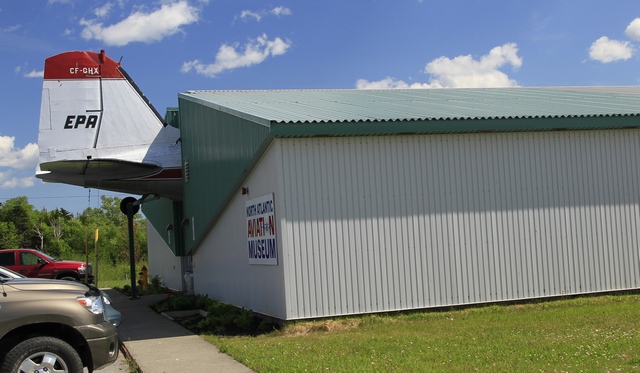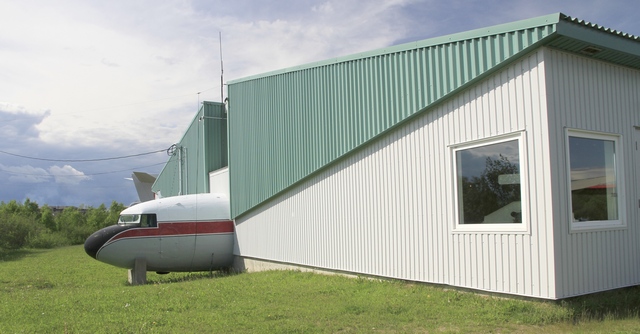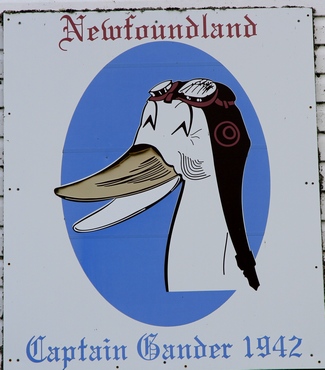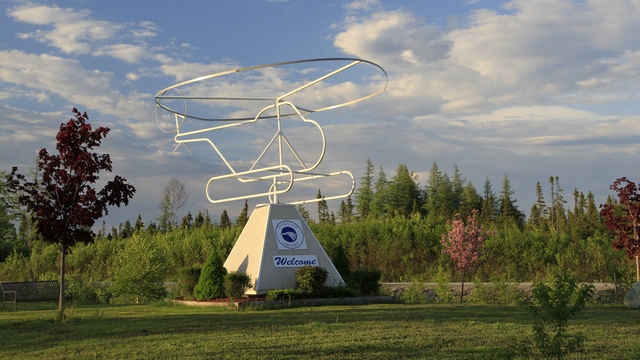24/06: Gander
Category: General
Posted by: The Agnew Family
Time to leave beautiful Gros Morne National Park and start heading east. Today we are driving as far as Gander, about 375 kilometers. After settling in we drive over to the North Atlantic Aviation Museum. The front of the building looks like this

the tail of a DC 3

The back of the building is the nose of the DC-3
How Gander came to be is an interesting story. In 1935, The British Overseas Airways Corporation came to Newfoundland to find a suitable place for an airport. Their motivation was profit and pit stops, airplanes need to refuel before they flew across the Atlantic. They found Hattie`s Camp -- an abandoned sawmill at Mile 213 of the Newfoundland Railway. The land was flat, accessible by rail and close to a lake suitable for landing sea planes. Within three short years, Hattie`s Camp became not just an airport but the largest airport in the world. Somewhere along the way, Hattie's Camp became known as Gander. Gander was a hub of activity during WWII as it was used as the departure point for planes being sent to England. After WWII, Gander became a hub of international travel. Just about every plane heading to or from Europe stopped to refuel. The invention of the jet engine changed things for Gander as planes no longer need to stop to refuel. On September 11, 2001 Gander was temporarily a busy airport. With the closing of air space in both Canada and US, 40 planes landed at the Gander Airport. The town of 10,000 rallied finding food and accommodation for 6,600 passengers.

This sign is on a building out at the old seaport.

When we drove around town we noticed several pipe airplanes. This helicopter is just outside of the RV.

the tail of a DC 3

The back of the building is the nose of the DC-3
How Gander came to be is an interesting story. In 1935, The British Overseas Airways Corporation came to Newfoundland to find a suitable place for an airport. Their motivation was profit and pit stops, airplanes need to refuel before they flew across the Atlantic. They found Hattie`s Camp -- an abandoned sawmill at Mile 213 of the Newfoundland Railway. The land was flat, accessible by rail and close to a lake suitable for landing sea planes. Within three short years, Hattie`s Camp became not just an airport but the largest airport in the world. Somewhere along the way, Hattie's Camp became known as Gander. Gander was a hub of activity during WWII as it was used as the departure point for planes being sent to England. After WWII, Gander became a hub of international travel. Just about every plane heading to or from Europe stopped to refuel. The invention of the jet engine changed things for Gander as planes no longer need to stop to refuel. On September 11, 2001 Gander was temporarily a busy airport. With the closing of air space in both Canada and US, 40 planes landed at the Gander Airport. The town of 10,000 rallied finding food and accommodation for 6,600 passengers.

This sign is on a building out at the old seaport.

When we drove around town we noticed several pipe airplanes. This helicopter is just outside of the RV.